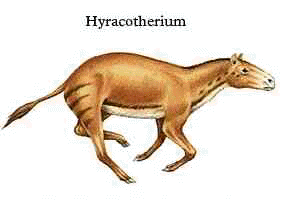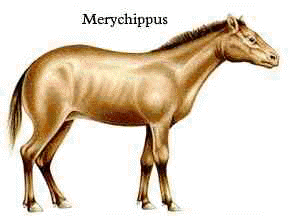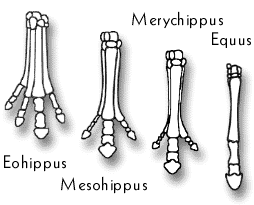Horse Evolution
This is merely the summary of a
comprehensive article
Horse Evolution
by Kathleen Hunt which appears on The TalkOrigins. Archive.
Several informative links can be found at the bottom of the page.
For many people, the horse family remains the classic example of evolution. As more and more horse fossils have been found, some ideas about horse evolution have changed, but the horse family remains a good example of evolution. In fact, we now have enough fossils of enough species in enough genera to examine subtle details of evolutionary change, such as modes of speciation.
In addition to showing that evolution has occurred, the fossil Equidae also show the following characteristics of evolution:
- Evolution does not occur in a straight line toward a goal, like a ladder; rather, evolution is like a branching bush, with no predetermined goal.
Horse species were constantly branching off the "evolutionary tree" and evolving along various unrelated routes. There's no discernible "straight line" of horse evolution. Many horse species were usually present at the same time, with various numbers of toes, adapted to various different diets. In other words, horse evolution had no inherent direction. We only have the impression of straight-line evolution because only one genus happens to still be alive, which deceives some people into thinking that that one genus was somehow the "target" of all the evolution. Instead, that one genus is merely the last surviving branch of a once mighty and sprawling "bush".
The view of equine evolution as a complex bush with many contemporary species has been around for several decades, and is commonly recounted in modern biology and evolution textbooks.
- There are no truly consistent "trends".
Tracing a line of descent from Hyracotherium to Equus reveals several apparent trends: reduction of toe number, increase in size of cheek teeth, lengthening of the face, increase in body size. But these trends are not seen in all of the horse lines. On the whole, horses got larger, but some horses (Archeohippus, Calippus) then got smaller again. Many recent horses evolved complex facial pits, and then some of their descendants lost them again. Most of the recent (5-10 My) horses were three-toed, not one-toed, and we see a "trend" to one toe only because all the three-toed lines have recently become extinct.
Additionally, these traits do not necessarily evolve together, or at a steady rate. The various morphological characters each evolved in fits and starts, and did not evolve as a suite of characters. For example, throughout the Eocene, the feet changed little, and only the teeth evolved. Throughout the Miocene, both feet and teeth evolved rapidly. Rates of evolution depend on the ecological pressures facing the species.
The "direction" of evolution depends on the ecological challenges facing the individuals of a species and on the variation in that species, not on an inherent "evolutionary trend".
- New species can arise through several different evolutionary mechanisms.
Sometimes, new species split off suddenly from their ancestors (e.g., Miohippus from Mesohippus) and then co-existed with those ancestors. Other species came into being through anagenetic transformation of the ancestor, until the ancestor had changed appearance enough to be given a new name (e.g. Equus from Dinohippus). Sometimes only one or a few species arose; sometimes there were long periods of stasis (e.g. Hyracotherium throughout the early Eocene); and sometimes there were enormous bursts of evolution, when new ecological opportunities arose (the merychippine radiation). Again, evolution proceeds according to the ecological pressures facing the individuals of a species and on the variation present within that species. Evolution takes place in the real world, with diverse rates and modes, and cannot be reduced to a single, simple process.
A Question for Creationists:
Creationists who wish to deny the evidence of horse evolution should careful consider this: how else can you explain the sequence of horse fossils? Even if creationists insist on ignoring the transitional fossils (many of which have been found), again, how can the unmistakable sequence of these fossils be explained? Did God create Hyracotherium, then kill off Hyracotherium and create some Hyracotherium-Orohippus intermediates, then kill off the intermediates and create Orohippus, then kill off Orohippus and create Epihippus, then allow Epihippus to "microevolve" into Duchesnehippus, then kill off Duchesnehippus and create Mesohippus, then create some Mesohippus-Miohippus intermediates, then create Miohippus, then kill off Mesohippus, etc.....each species coincidentally similar to the species that came just before and came just after?Creationism utterly fails to explain the sequence of known horse fossils from the last 50 million years. That is, without invoking the "God Created Everything To Look Just Like Evolution Happened" Theory.
[And I'm not even mentioning all the other evidence for evolution that is totally independent of the fossil record -- developmental biology, comparative DNA & protein studies, morphological analyses, biogeography, etc. The fossil record, horses included, is only a small part of the story.]
Truly persistent and/or desperate creationists are thus forced into illogical, unjustified attacks of fossil dating methods, or irrelevant and usually flat-out wrong proclamations about a supposed "lack" of "transitional forms". It's sad. To me, the horse fossils tell a magnificent and fascinating story, of millions of animals living out their lives, in their natural world, through millions of years. I am a dedicated horse rider and am very happy that the one-toed grazing Equus survived to the present. Evolution in no way impedes my ability to admire the beauty and nobility of these animals. Instead, it enriches my appreciation and understanding of modern horses and their rich history.
"All the morphological changes in the history of the Equidae can be accounted for by the neo-Darwinian theory of microevolution: genetic variation, natural selection, genetic drift, and speciation." (Futuyma 1986, p.409)
"Because its complications are usually ignored by biology textbooks, creationists have claimed the horse story is no longer valid. However, the main features of the story have in fact stood the test of time...." (Futuyma 1982, p. 85)
"When asked to provide evidence of long-term evolution, most scientists turn to the fossil record. Within this context, fossil horses are among the most frequently cited examples of evolution. The prominent Finnish paleontologist Bjorn Kurten wrote: 'One's mind inevitably turns to that inexhaustible textbook example, the horse sequence. This has been cited -- incorrectly more often than not -- as evidence for practically every evolutionary principle that has ever been coined.' This cautionary note notwithstanding, fossil horses do indeed provide compelling evidence in support of evolutionary theory." (MacFadden 1988, p. 131)
"The fossil record [of horses] provides a lucid story of descent with change for nearly 50 million years, and we know much about the ancestors of modern horses." (Evander 1989, p. 125)
"It is evolution that gives rhyme and reason to the story of the horse family as it exists today and as it existed in the past. Our own existence has the same rhyme and reason, and so has the existence of every other living organism. One of the main points of interest in the horse family is that it so clearly demonstrates this tremendously important fact." (Simpson, 1961, p. xxxiii)



To read the complete article please follow this link
and other links
Fossil Horses: Othniel Charles Marsh's Proof for Darwin's
Theory of Evolution (off site)Is "Dawn Horse" a Hyrax?
Examining a Common Creationist Claim About Hyrocotherium (off site)
Michael HopkinsDid Hyracotherium and Equus Live at the Same Time (off site)
Jon BarberFossil Horses in Cyberspace (off site)
"Learn about paleontology and evolution by exploring the rich fossil record of horses "The Evolution of the Horse (off site)
Deb Bennett, Ph.D.
Equine Studies Institute
Smithsonian Institution, Washington, D.C.